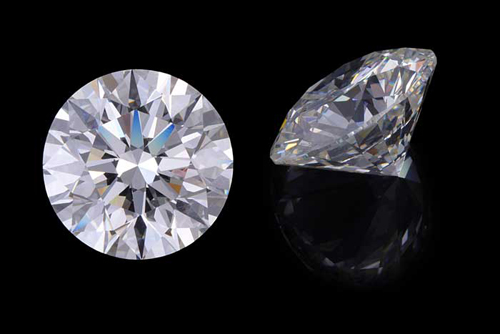
Technology has allowed man-made diamonds to become so similar to mined diamonds that they’re working their way into the jewelry market, for better or worse, with some budget-conscious shoppers requesting them as a cheaper alternative.

Local jewelers disagree with a recent Chicago Tribune report that lab-created diamonds are gaining popularity among price-motivated consumers.
Dan Foss, owner of Foss Jewelers in Selinsgrove, Wayne Reed, owner of Island Park Jewelers in Sunbury and Mifflinburg, and Kirby Fedder, owner of Fedder’s Jewelers in Milton, said they don’t carry lab-created diamonds and have had few inquiries from customers about them.
“I only sell natural diamonds with GIA (Gemological Institute of America) lab reports and I sell a lot of them,” said Foss, a third generation jeweler who has been in the industry since 1985. “To me, selling lab-created diamonds takes all of the mystery, romance and one-of-a-kind aspect out of the engagement ring process. Imagine if the Hope Diamond was lab created.”
Jewelers, according to the Chicago Tribune, are noticing a change in that blind devotion toward the gemstone in its natural form.
Technology has allowed man-made diamonds to become so similar to mined diamonds that they’re working their way into the jewelry market, for better or worse, with some budget-conscious shoppers requesting them as a cheaper alternative.
Reed, owner of the two stores since 2007, and Fedder, a third generation jewelery who opened his own business 30 years ago, said they won’t keep any lab-created diamonds in stock.
“I don’t want that reputation,” Reed said. “I can get them overnight. I don’t want to accidentally get them mixed up with the (natural) diamonds.”
“I sell natural gems,” Fedder said. “I sell very few artificial or simulated stones. According to the industry, it’s a small market. If someone asked, I would look into it.”
In Foss’s three decades of experience, he said he has had only one customer ask about lab-created diamonds. Reed said he sold three in eight years. Fedder said he never had anyone ask him about it.
“It is the same with lab created gemstones such as rubies, emeralds and sapphires,” Foss said. “Big box stores sell them, but I will not for the same reasons I mentioned earlier.”
The internet has changed the way diamonds are sold for the better, Foss said.
“Lab reports, especially ones from the Gemological Institute of America (the strictest lab in the industry) has removed the shroud of uncertainty when selecting a natural Diamond,” Foss said. “All the quality aspects are right there in black and white. I rely on GIA lab reports for all my customers and know that I am selling the best quality and using the strictest grading possible.”
A study by the Gem & Jewellery Export Promotion Council estimated that lab-grown diamond production is 350,000 carats compared to 125 million carats of natural diamonds, which represents less than 1 percent of the industry.
However, there are no reliable estimates for how many synthetic diamonds are produced each year, said Tom Moses, executive vice president of laboratory and research at GIA, the Carlsbad, Calif.-based organization that grades and tests diamonds. But he expects their prevalence to grow, especially if there’s interest in the marketplace.
Some jewelry brands already are looking at man-made diamonds and seeing opportunity instead of threats. They’re more affordable than real diamonds (some estimates say they cost about 20 to 30 percent less), are seen as environmentally friendly and marketed as a surefire way to avoid blood diamonds.
“Whether we like them or not, if you want to keep advancing in this business, you have to accept them for what they are,” said Jonathan Villegas, store manager at Diamonds by Shelly. The Jewelers Row shop doesn’t promote synthetic diamonds, but has some on hand in case anyone asks. It’s mostly millennials that request them, Villegas said.
Morals aside, there’s still a major problem with the man-made sparkly stuff: No one knows how the value will change as more inventory comes on the market.
Some worry that pawnshops won’t pay much for them, and that few will be eager to inherit their grandmother’s synthetic diamond rings. The market knows that diamonds are forever, but it’s not quite sure yet what happens when those diamonds are man-made.
“Where’s the value in something you can make a billion of?” said Garry Zimmerman, co-owner of Windy City Diamonds. “I can’t in good conscience sell something that I think is intrinsically going to lose its value.”
The rise in prevalence of lab-created diamonds has left diamond sellers concerned that the synthetics could creep into their inventory unannounced, especially during the holiday shopping season, one of the year’s busiest times for jewelry sales.
Show those shoppers a man-made diamond, and they wouldn’t be able to tell the difference. Even the trained eye needs tools to differentiate.
“Visually, you wouldn’t see the difference,” said Moses
Synthetic diamonds are used primarily in electronics or for industrial purposes. Those big blades you sometimes see construction crews using to saw the highway, for example, are embedded with synthetic diamonds, Moses said. The first commercially viable man-made diamond was created in the 1950s.
There are no reliable estimates for how many synthetic diamonds are produced each year, Moses said. But he expects their prevalence to grow, especially if there’s interest in the marketplace.
“I think right now we’re in sort of a confusion state,” he said. “In the coming years, I don’t know exactly what the timeline is, but I think we’ll have two clear, distinct paths, one for natural and one for man-made.”